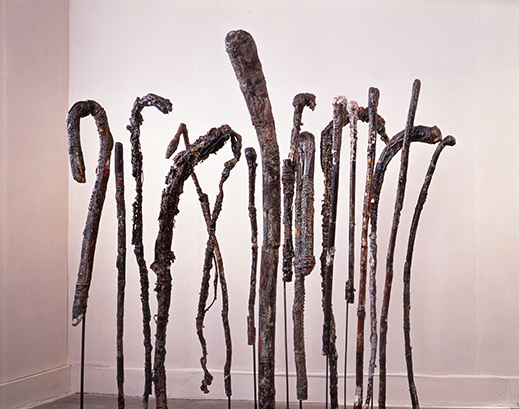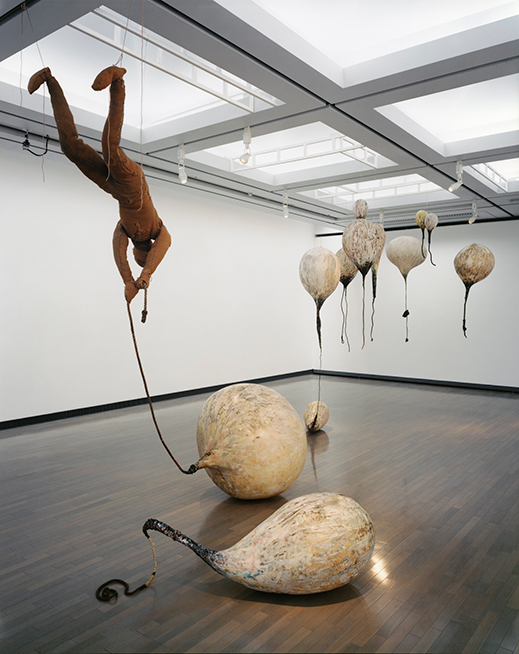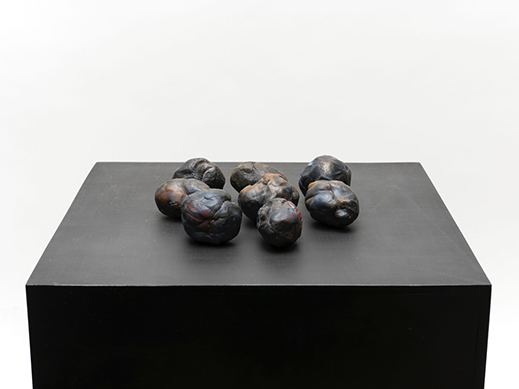 |
Focus features two in-depth reviews each month of fine art, architecture and design exhibitions and events at art museums, galleries and alternative spaces around Japan. The contributors are non-Japanese residents of Japan. |
|
|
 |
 |
 |
Plenty of Nothing: The Michio Fukuoka Exhibition
Christopher Stephens |
 |
SAND 2 (1956, collection of the artist). Photo: Kazuo Fukunaga |
The sculptor Michio Fukuoka, born in Sakai, Osaka Prefecture in 1936, spent the better part of his 60-year career struggling to make art freely while freeing himself from the need to make anything at all. This relentless existential dilemma led Fukuoka down many paths and through periods of activity and inactivity, culminating in his 2005 decision to become "a sculptor who no longer sculpts." Fortunately, the results of his efforts are still very much extant and can currently be seen in a wide-ranging retrospective at the National Museum of Art, Osaka.
Fukuoka made his debut in the mid-'50s. Avoiding the open-call group exhibitions that were almost mandatory for artists of the era, he held his first solo show a few years later. Even at this early stage, Fukuoka was determined to short-circuit the art establishment. Rather than consciously mold a shape and visually verify the outcome, in his first major series, SAND, Fukuoka dug a hole in the ground, poured plaster inside, and fumbled around blindly until he arrived at something that felt right. The results tended toward the primitive -- vaguely human shapes with undefined features that might be mistaken for figurines from the ancient Jomon Period. This way of working reflected Fukuoka's conviction that "the greater your will to create something that looks like sculpture, the more you make forgeries that wear the mask of truth."
 |
|
Nothing to Do (1962-64, Osaka City Museum of Modern Art). |
In the '60s, Fukuoka attempted to further undermine sculptural standards like vertical orientation and superhuman scale. The Nothing to Do series consists of bent and bumpy wooden rods with waste materials that the artist collected from the roadside strapped to them, and an outer layer of molten polyethylene. Some of the sticks are attached to metal mounts or arranged in groups of a dozen or more in a small pool of gravel. The objects have an eerie totemic quality, as if they are the charred remnants of some dark ritual. The title refers to Fukuoka's compulsion to create but inability to find anything worth creating.
Fukuoka followed this with what is probably his most visually compelling series, Pink Balloons. In one of the works, Why Did I Ever Fly?, a brown human figure made of burlap floats in the air with a rope in its hands while a dirt-flecked balloon at the other end sits heavily on the floor surrounded by several other balloons, some aloft, others earthbound. According to Fukuoka, the pink color signifies "sighs" and the balloon motif the disappointment of never reaching great heights and the regret for having aspired to them in the first place.
 |
|
Why Did I Ever Fly? (1965-66, collection of the artist). Photo: Shizune Shiigi |
Like many artists of his generation, Fukuoka did his best to dismantle conventional artistic notions by making things that lay far outside defined boundaries of expression and reestablishing a link between art and everyday life. In his anti-sculpture, he dispensed with pedestals, avoided robust materials like stone or metal, and incorporated pink and other brilliant colors.
By the early '70s, however, Fukuoka began to find rebelling against tradition just as difficult as supporting emerging trends like Mono-ha ("School of Things"), a group of artists who dominated the period with their explorations of natural and artificial materials. For the first time, figurative art seemed to be the best form of subversion, as seen in Fukuoka's The Carcass of Pink and the Descent of Black. In this work, a huge and highly realistic black moth, made of FRP (fiber-reinforced plastic), threatens to crush a soft pink sack, suggesting perhaps the artist's anxious feelings toward art.
The Carcass of Pink and the Descent of Black (1972, collection of the artist). Photo: Kazuo Fukunaga |
After taking this style as far as he could, Fukuoka distanced himself from the art world and spent the next few years fishing. He eventually reemerged with a series of "landscape sculptures." Using a solid black FRP block as a base, each work depicts a mundane scene from everyday life such as a man (the artist?) sitting under a tree with his fishing line in the black ripples of a pond or casting a stone into the water from a small mound of land in one corner of the block. Is Weeding a Disease? shows a small figure pulling weeds in a field across from a pink abstract object that dwarfs him in size. Perhaps "weeding" here means making things, and the object, resembling a stylized internal organ, is an embodiment of art. Fukuoka compared these works to diary entries due to their everyday themes and his habit of making them on a daily basis. In time, the figures disappeared, leaving only a series of blank surfaces covered with indistinct waves.
 |
|
Is Weeding a Disease? (1990, collection of the artist). Photo: Kazuo Fukunaga |
Fukuoka stuck with the landscapes for over 20 years until once again reaching a dead end. Next, he embarked on the Text series, in which he engraved hundreds of Japanese and English phrases like "nothing to do" across the surface of a black FRP panel, creating an attractive woven pattern and shifting attention away from semantic meaning. The works resemble a stele from an ancient civilization or traces of a blackboard punishment. This simple operation kept Fukuoka's hands busy and his mind off the gnawing question of "sculpturality."
In 2004, having come to the conclusion that he was destined to endlessly repeat himself, Fukuoka closed the door on art with Shriveled-up Balls. The series consists of dark misshapen clumps of FRP, none larger than a fist, in what seems to be one last dig at sculpture, a largely masculine institution characterized by expressions of power and authority. Fukuoka's balls were impotent and unattractive, lying shriveled and spent for all to see on top of a pedestal. Perhaps they are also a symbol of the artist's own sense of defeat.
Some 50 years earlier Fukuoka had said, gTo be an artist without making anything, to exist as an artist without expressing anything -- that is my ideal.h He had at last realized his goal, reducing sculpture to a thought process -- no more or less important than fishing or weeding -- and returning to the business of living.
 |
|
Shriveled-up Balls (2004-5, collection of the artist). Photo: Kazuo Fukunaga |
All works by Michio Fukuoka; all images provided by the National Museum of Art, Osaka.
|
 |
 |
Christopher Stephens
Christopher Stephens has lived in the Kansai region for over 25 years. In addition to appearing in numerous catalogues for museums and art events throughout Japan, his translations on art and architecture have accompanied exhibitions in Spain, Germany, Switzerland, Italy, Belgium, South Korea, and the U.S. His recent published work includes From Postwar to Postmodern: Art in Japan 1945-1989: Primary Documents (MoMA Primary Documents, 2012) and Gutai: Splendid Playground (Solomon R. Guggenheim Museum, 2013). |
|
 |
|